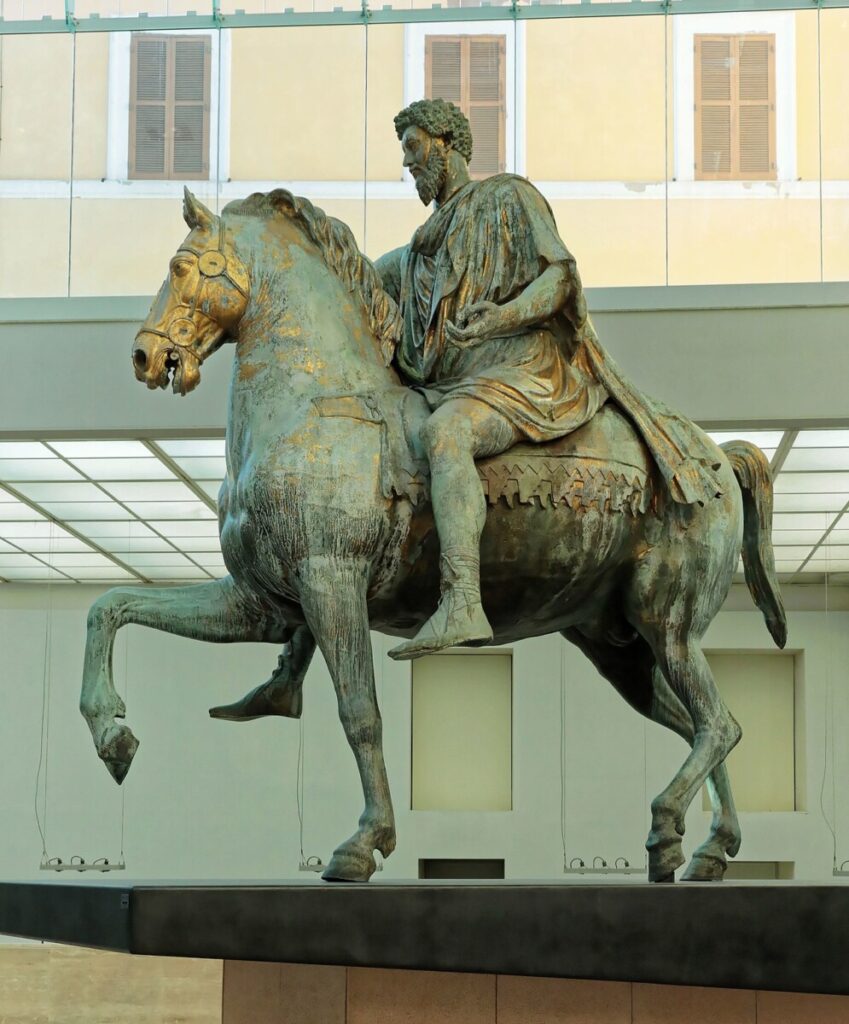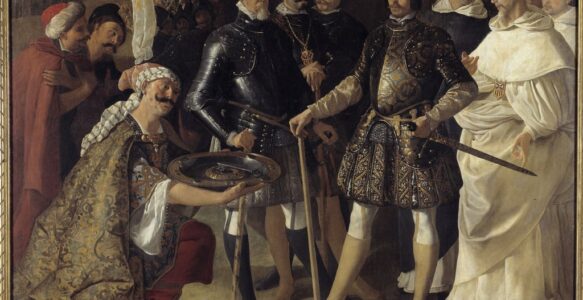During the Baroque period, Spain was at the height of its Golden Age; a time where Spain’s territory reached throughout the entire world and brought Spain immense wealth, influence, and power. Spain’s royal family, the ceremonial and political head of the Spanish Empire, sought to utilize art to furnish its image as the principal institution of the Spanish Empire. In doing so, the Spanish Royal Family employed art to assert their identity and project military power during the Baroque period.
The Spanish Royal Family utilized art in order to project their image and stature throughout their empire. The portrait Philip IV, 1624 by Diego Velazquez, portrays the full body of the Spanish king. In the portrait, Philip IV is wearing a black dress, typical for anyone in the Spanish court, adorned by a gold chain across his body holding a pendant. By depicting Philip IV with little ornamentation, both in his clothing and in the background of the portrait, Velazquez is able to illustrate the king’s presence with simplicity and without the need for any substantial symbolism[1]. In addition, the simplicity of the portrait itself helps keep the viewer’s attention on the King, allowing the King’s posture, face, and stature to take up most of the space of the portrait.

Although the portrait of Philip IV by Velazquez seems rather simple, some of the design choices Velazquez makes in representing the King help further cement Philip IV’s role as the head of the empire and a figure to be revered by all. Velazquez portrays Philip IV facing slightly leftward, with his left foot angled to the left and his right foot facing straightforward. This posture resembles the one of Philip IV’s grandfather, Philip II, who used it in daily activities with others[2]. As a result, the work conveys Philip IV as a person who fully inhabits the position of King and someone who conducts stately affairs on behalf of Spain. The portrayal of the King was relevant for the Spanish Royal Family because at a time, most of their subjects throughout the world were illiterate and wouldn’t get the chance to see Philip IV in-person. Hence, Philip IV’s portrait served as the only method in which Spanish subjects would be able to know and interact with their King. By doing so, the portrait acted as a visual imprint of the King for millions of people that the King would never directly interact with and would help establish the importance of the Spanish Crown through the Spanish Empire.
The Spanish Royal Family also utilized art to situate themselves within the traditions of classicism. In the work The Family of Philip V, 1743, by Louis-Michel van Loo, the artist portrays the family of the Spanish king in regal clothes, with the men wearing fine stately clothes and women wearing elaborate dresses[3]. The background of the painting is dramatic, with soaring Roman arches, tall Corinthian columns, and a grand marble floor adorned with geometric designs. These aspects of the background are relevant since they all are elements of Greco-Roman architecture. By placing the Spanish royal family within a grand ballroom surrounded by Greco-Roman architecture, the artist is making a connection between the Spanish Royal Family and the Roman Empire, almost implying that the Spanish Royal Family is continuing the traditions and values of the Roman Empire.

The Spanish Royal Family also employed art to demonstrate the military power the royal family held within the Empire and throughout the world. The Equestrian Statue of Philip IV, 1640, by Pietro Tacca, displays the Spanish King on top of a horse holding a baton[4]. In the bronze statue located in Madrid, Philip IV is wearing military armor and appears in a triumphant position, with his horse in an upward stance. By portraying Philip IV in this format, Tacca is displaying the Spanish King more like a high military general rather than just a stately king who lives in a palace, supporting the narrative that the Spanish King is a soldier in his own right and a source of military power.
The Equestrian Statue of Philip IV holds many similarities to equestrian statues of the past, like the Equestrian Statue of Marcus Aurelius, 175 AD. In this bronze statue of Marcus Aurelius, the Roman Emperor, Marcus is on top of a horse with his right arm outstretched. Similar to the equestrian statue of Philip IV, this statue of Marcus Aurelius depicts him in a position of power, with Marcus about to address troops and sitting in a position of grandeur on top of a horse[5]. One difference between the two statues is that in the statue of Marcus Aurelius, he is unarmed[2], which may reflect more on his principles as someone to protect peace rather than a leader intent on military victory. By including arms on the Equestrian Statue of Philip IV, the Spanish Royal Family was emphasizing how the Spanish King was a military leader that carried power throughout the Spanish Empire.


The Spanish Royal Family’s military power was also present in the Equestrian Portrait of Charles V, 1548,by Titian. In this portrait, Charles V is wearing all the trappings of a military commander, with grey and gold-colored military armor, a metal spear, a metal helmet, and is on top of a horse with its head pointed downward. These artistic choices place Charles V within an “atmosphere of splendor”[1] and portray the Spanish King like a military general. Here, viewers don’t see a regal King, but a glorious military general heading off to battle; as a result, the portrait again supports the narrative that the Spanish King is a military leader that leads their own battles and armies. Regardless of whether this narrative was true, it was important for the Spanish Royal Family to portray it due to the enormous size and wealth of the Spanish Empire, which made it necessary to demonstrate that the Spanish King had the strength and capacity to rule over and protect a massive empire that stretched over the world.

The work The Surrender of Seville before Ferdinand III King of Castile and Leon with Saint Peter Nolasco, 1248, made in 1628 by Francisco de Zubarán, portrays the functions of both projecting military power and asserting identity in one painting. In the work, the Moors are handing over the city of Seville to the King of Castile and Leon, Ferdinand III[6]. The Moorish figures are shown on the left, with one bending their knees and offering a plate to Ferdinand III. On the right, the King is surrounded by religious and military figures, wearing white clothes and black military armor respectively. From the vantage point of identity, the work displays Ferdinand III as a King who was involved in affairs of state and played an integral role in the recapture of Seville, an important moment in the history of the Reconquista. This historical moment, which occurred centuries before Spain was reunified, was important for the Spanish Royal Family to portray since it illustrated that the Royal Family was involved in the reunification of Spain and hence not only currently held power throughout the Spanish Empire, but throughout Spain for centuries.
From the vantage point of military power, The Surrender of Seville before Ferdinand III King of Castile and Leon with Saint Peter Nolasco portrays the Spanish King as the leader not just of the Spanish delegation, but also of the Spanish military that was successful in taking back Seville from the Moors. Ferdinand III is displayed in elaborate military armor and holding the baton of command[6], illustrating his position as the leader of the military and in charge of the battle to take back Seville. As a result, Zubarán is portraying Ferdinand III as a King who is a tremendous military leader who has the capacity to win significant battles. For the Spanish Royal Family, this example of military strength is pertinent since it portrays the Spanish Royal Family accomplishing a significant military victory, which can demonstrate to viewers during the Baroque period throughout the world that the Spanish Crown is capable to successfully fighting battles if necessary to protect the territorial sovereignty of the Spanish Empire. As a result, the work not only emphasizes the military power of the Spanish Royal Family, but also acts as a deterrent to those who may wish to rebel against the Spanish Empire.

Through a variety of works spanning the Baroque Period, the Spanish Royal Family was able to utilize art to project their image and military power throughout their empire. From utilizing portraiture to depict Spanish monarchs as austere, divine figures, to illustrating the Royal Spanish Family as the inheritors of the legacy of the Roman Empire, or to illustrating the military conquests of the Spanish crown in the past, art became a powerful tool for the Royal Family to present their preferred narrative about their place in society and solidify their reputation as the paramount head of the Spanish Empire. Through a better understanding of the role Spanish Royal Art played in society during the Baroque Period, people today may gain a better understanding of how Spanish colonial history influences our world and how art can be employed to better reflect people historically marginalized.
A Google Site accompanying this essay can be found here.
References
[1] Brown, Michael A., et al. Art & Empire: The Golden Age of Spain. The San Diego Museum of Art, 2019, p. 34.
[2] Volk, Mary Crawford. “Of Connoisseurs and Kings: Velazquez’ Philip IV at Fenway Court.” Fenway Court 1985, 1986, p. 27-28.
[3] Ciechanowska, Helena, et al. “The Picture: Spain.” The Oxford History of Western Art, Oxford University Press, Oxford, 2002, p. 233.
[4] Harris, Ann Sutherland. “Spain.” Seventeenth-Century Art and Architecture, Prentice Hall, Upper Saddle River, NJ, 2005, p. 198.
[5] Stewart, Peter, and Marcel van Ackeren. “The Equestrian Statue of Marcus Aurelius.” A Companion to Marcus Aurelius, Wiley-Blackwell, Malden, 2012, p. 267.
[6] Olson-Rudenko, Jennifer, et al. “Francisco De Zurbarán’s The Surrender of Seville to King Ferdinand III of Castile and Leon with Saint Peter Nolasco, 1248 for the Calced Mercedarians of Seville.” Spanish Royal Patronage 1412-1804: Portraits as Propaganda, Cambridge Scholars, Newcastle upon Tyne, 2018, p. 104.
